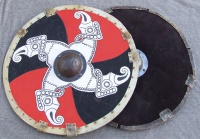Centre boss
A centre-boss shield was a type of round, oval, oblong or coffin-shaped shield common in period. It has called a centre-boss because of the single central grip, protected by a metal boss. Most centre-boss shields actually had a hole in the centre with the grip flush or adjacent to the hole under the boss, with the protective boss projecting outward from the shield face itself. Most centre-boss shields appear to be flat, but the best-quality centre-boss shields were lenticular (lens-shaped), that is, having a slightly conical shape back from the centre boss itself. As extent curved planks of wood for shields have been found with wooden shield bosses and flat boards with decorated iron bosses, personal, economic or regional variations can be found.
Lenticular centre-boss shields had the benefit of structural strength in addition to the resiliency of wood and rawhide, in the same way that a dome is stronger than a flat roof.
Centre-boss shields were commonly used by the Anglo-Saxons and Norse, but were known across the medieval world.
Centre Boss Shields By Culture
Saxon Centre Boss Shields
There is relatively small amounts of archeological evidence for the dimensions of Saxon shields, but an extent shield from the Sutton Hoo place that shield at between 84 to 96cm with inferences that others were much smaller. Board fragments have so far been poplar or willow for half the found specimens, a quarter were lime and the reminder were of alder, ash, beech, birch, maple or oak. The board thicknesses appear to increase over time from 6.5mm on average during the 5th century to 8.5 in the late 6th to 7th centuries. A carrying strap could be attached by metal plaques (as in the Sutton Hoo Ship Burial) or a simple leather thong wrapped around the grip (Pewsey find). Decorative metal plaques could also be added to the face. The shield would be covered on both sides with leather. Housecarls were specifically instructed not to use leather from sheep for this purpose. Iron handgrips (and one copper alloy) are known that lap around a wooden core. Typically the grip would be riveted to the shield separately to the boss. Rims may have been of leather, metal or rawhide although no archeological evidence has supported this to date.
Archeological evidence indicates that Saxon shields were likely flat or curved in the vertical plane only. This is reinforced by some pictorial depictions.
Viking Centre Boss Shields
Historically these shields had metal or wooden bosses in the centre riveted to the wooden planked body which could be up to 95cm in diameter. Behind the shield is a wooden (sometimes covered in a metal sheath) or metal crossbar to act as a grip. The grip might also be covered in leather and the ends of the handle might have bronze termini attached. The face and back of the shield could be covered in leather or rawhide and painted. Guiges were most commonly attached using rings and eyelets.
Centre Boss Shields in Combat
Centre-boss shields are handled very differently from other shield types (such as the kite shield or the heater shield) which are strapped to the arm. Tending to be light-weight, a centre-boss shield can be "punched" towards an incoming blow.
Centre boss shields were commonly used in shield walls, as they were the state of the art at the time of Alfred the Great, who perfected the shieldwall technique. Large centre-boss shields allowed for the easy overlap of the edges of the shields, providing great strength and rigidity to the formation. With sufficient skill and training, the shieldwall can be quickly opened and closed to allow other fighters to slip through the ranks, either to charge or retreat.
External Links
- Information on Viking Centre Boss Shields
- Making a re-enactment Viking Age Shield
- Making a Planked Linden Shield
References
The Anglo-Saxon Shield, Stephenson, I.P. 2002
